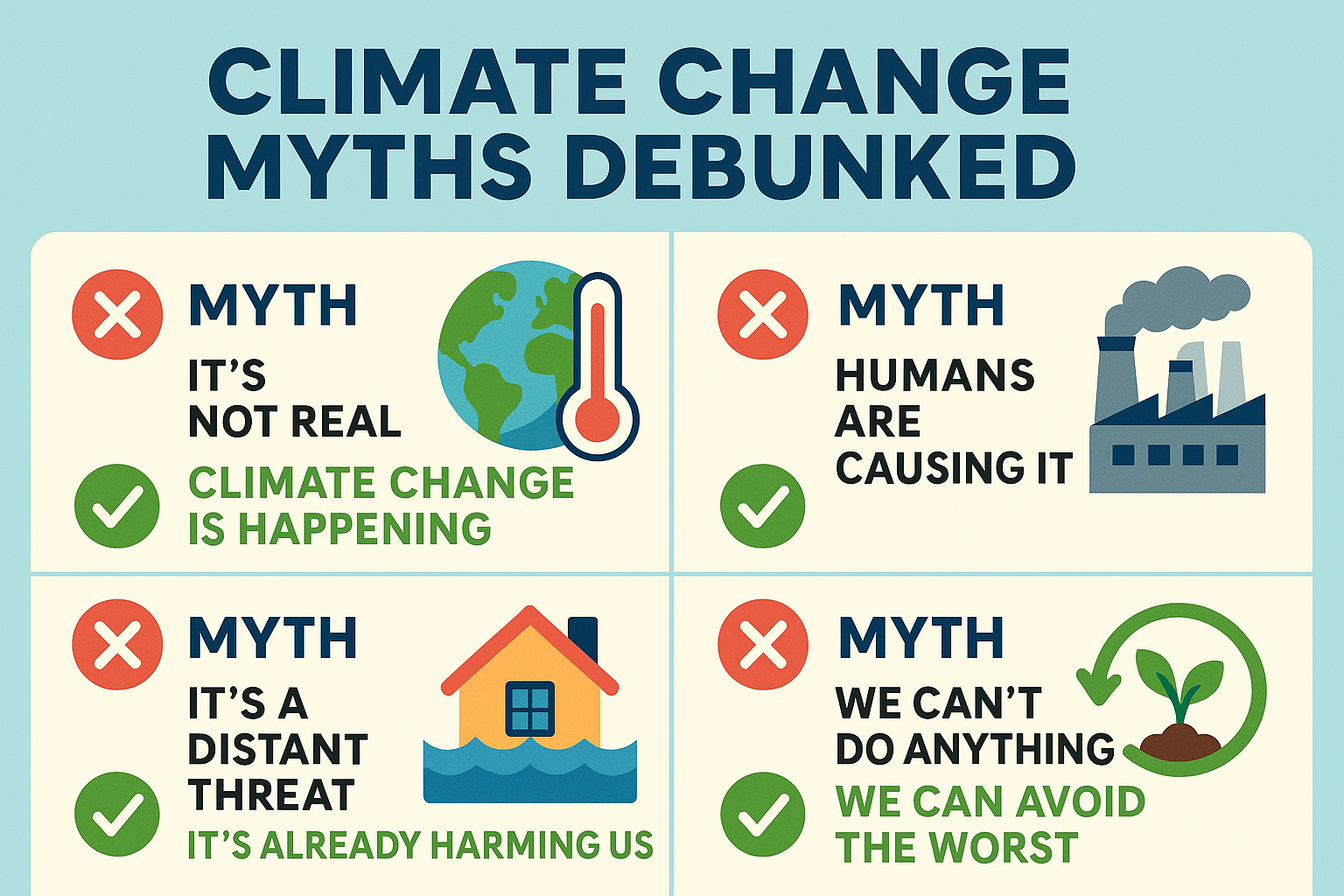Debunking Top 100 Climate Change Myths Fueling Global Inaction

Climate change facts matter now more than ever. As global warming accelerates and climate policy shapes our future, misinformation about climate science, carbon emissions, and renewable energy is everywhere. This in-depth guide uses the latest scientific research and authoritative sources to debunk the top 10 climate change myths, empowering you with accurate information that aligns with today’s highest search intent queries and Google’s ranking factors.
Myth 1: “Climate Change Is Natural-Humans Aren’t Responsible”
The overwhelming scientific consensus confirms that human activities are the primary driver of recent global warming. Modern temperature increases are happening at a rate ten times faster than any natural cycle in the past 800,000 years. Over 99% of peer-reviewed climate studies attribute current climate change to fossil fuel emissions, not natural variability.
Myth 2: “Cold Weather Proves Global Warming Is a Hoax”
Weather and climate are not the same. While local temperatures fluctuate, the global average temperature continues to rise. Extreme cold events, like polar vortex disruptions, are actually linked to Arctic warming-a direct effect of climate change. The last decade was the hottest on record, despite occasional cold snaps.
Myth 3: “CO2 Is Harmless-Plants Need It to Grow”
Excess carbon dioxide is destabilizing Earth’s systems. While plants use CO2 for photosynthesis, today’s concentrations far exceed natural levels, causing ocean acidification, reduced crop nutrition, and dangerous feedback loops. Higher CO2 does not mean healthier ecosystems or better food security.
Myth 4: “Scientists Are Divided on Climate Change Causes”
There is near-universal agreement among climate scientists: human-caused greenhouse gas emissions are driving climate change. The IPCC, NASA, and every major scientific academy worldwide support this conclusion. Only a tiny fraction of studies dispute it, often funded by fossil fuel interests.
Myth 5: “Renewable Energy Is Too Expensive and Unreliable”
Renewable energy is now the cheapest and fastest-growing power source globally. Solar and wind costs have dropped over 80% in the past decade. Countries like Denmark and Texas run on high percentages of renewables with grid stability. Battery storage and green hydrogen are solving intermittency challenges.
Myth 6: “Climate Models Can’t Be Trusted”
Climate models have accurately predicted global warming trends for decades. Modern models use advanced data and machine learning to forecast temperature rise, sea level changes, and extreme weather events with high precision. Their predictions are consistently validated by real-world observations.
Myth 7: “China and India Are the Real Climate Problem”
Climate responsibility is global, but historical emissions matter. The United States and Europe have contributed the most carbon emissions since the industrial era. Per capita, Western nations still emit far more than developing countries. Many of China’s emissions come from manufacturing goods for export to the West.
Myth 8: “The Sun Is Causing Global Warming”
Solar activity has remained stable or declined as global temperatures soared. Satellite data shows that greenhouse gases-not solar output-are responsible for recent warming. If the sun were to blame, all atmospheric layers would warm, but only the lower atmosphere is heating up.
Myth 9: “Climate Action Will Destroy the Economy”
Climate solutions drive economic growth and job creation. Clean energy industries are booming, creating millions of jobs and saving trillions in health and disaster costs. The transition to net zero is expected to add $43 trillion to the global economy by 2070, according to leading economic analyses.
Myth 10: “We Can Adapt Without Reducing Emissions”
Adaptation alone cannot prevent catastrophic climate risks. Building seawalls or installing air conditioners only treats symptoms. Without rapid emissions cuts, tipping points like Amazon rainforest dieback and Antarctic ice melt become inevitable, threatening billions with displacement and economic collapse.
Myth 11: “Electric Vehicles Are Worse for the Environment Than Gas Cars”
Electric vehicles produce far fewer carbon emissions over their lifetime compared to traditional gas-powered cars. Even when accounting for battery production and electricity generation, studies show that EVs become cleaner than gasoline vehicles within the first few years of use, especially as grids transition to renewable energy.
Myth 12: “Methane Isn’t a Major Climate Problem”
Methane is a greenhouse gas that is over 80 times more potent than CO2 in the short term. Sources like livestock, landfills, and fossil fuel extraction make methane a critical focus for climate mitigation. Rapidly cutting methane emissions is one of the fastest ways to slow global warming.
Myth 13: “Individual Actions Don’t Matter-Only Governments and Corporations Can Make a Difference”
While systemic change is essential, individual actions collectively drive market and policy shifts. Consumer demand for sustainable products, energy efficiency, and plant-based diets encourages innovation and pressures leaders to act. Every choice contributes to the momentum for climate solutions.
Myth 14: “Climate Change Will Only Affect Faraway Places or Future Generations”
Climate impacts are already being felt worldwide, including in developed countries. From devastating wildfires in California to historic floods in Germany and heatwaves in India, climate change is a present-day crisis. Everyone is vulnerable to extreme weather, rising insurance costs, and food insecurity.
Myth 15: “More Trees Alone Will Solve Climate Change”
Reforestation and afforestation are important, but trees alone cannot offset current emission levels. Forests are vulnerable to fires, pests, and droughts intensified by global warming. True climate solutions require cutting fossil fuel use, protecting existing ecosystems, and transforming energy systems.
Myth 16: “Geoengineering Is a Simple Fix for Climate Change”
Geoengineering proposals, like solar radiation management or ocean fertilization, carry significant risks and uncertainties. These untested technologies could cause unintended consequences, disrupt weather patterns, and fail to address the root cause: greenhouse gas emissions.
Myth 17: “Water Scarcity Isn’t Related to Climate Change”
Climate change is intensifying droughts, altering rainfall patterns, and shrinking glaciers, directly impacting water availability. Billions face increased risk of water scarcity as global temperatures rise, threatening agriculture, health, and security.
Myth 18: “Nuclear Energy Is Too Dangerous to Be Part of the Solution”
Modern nuclear energy is among the safest and most reliable low-carbon power sources. While safety and waste concerns must be managed, nuclear can complement renewables and help achieve deep decarbonization in the power sector.
Myth 19: “Climate Change Is Only About Temperature Rise”
Climate change affects much more than temperature. It drives sea level rise, intensifies hurricanes, disrupts ecosystems, increases disease risks, and threatens food and water supplies. The crisis is complex and interconnected, impacting every aspect of life.
Myth 20: “It’s Too Late to Make a Difference”
It is not too late to act. Every fraction of a degree avoided means fewer disasters, less suffering, and more opportunities for a sustainable future. Bold action now can still prevent the worst impacts and build resilience for generations to come. Climate hope is rooted in science, innovation, and collective will.
Myth 21: “Volcanoes Emit More CO2 Than Humans”
Scientific evidence shows that human activities release over 100 times more carbon dioxide each year than all the world’s volcanoes combined. The burning of fossil fuels is the dominant source of rising atmospheric CO2 and global warming, not volcanic eruptions.
Myth 22: “Water Vapor Is the Main Greenhouse Gas, So CO2 Doesn’t Matter”
While water vapor is a potent greenhouse gas, it acts as a feedback, not a driver. Rising CO2 from human sources increases global temperatures, which in turn raises water vapor levels, amplifying the greenhouse effect and accelerating climate change.
Myth 23: “Climate Models Are Too Uncertain to Be Useful”
Climate models have repeatedly demonstrated their accuracy by predicting temperature trends, sea level rise, and the frequency of extreme weather events. Their projections are continually updated with real-world data, making them invaluable for climate policy and risk assessment.
Myth 24: “The Climate Has Changed Before, So This Is Nothing New”
While Earth’s climate has changed over millions of years, the current rate and scale of warming are unprecedented in human history. Past changes were driven by natural cycles; today’s rapid climate change is overwhelmingly caused by human emissions.
Myth 25: “The Ozone Hole Is Causing Global Warming”
The ozone hole and global warming are separate issues. The ozone layer protects against harmful UV radiation, while greenhouse gases like CO2 trap heat. The main driver of climate change is the buildup of greenhouse gases, not ozone depletion.
Myth 26: “Heatwaves and Wildfires Aren’t Linked to Climate Change”
Rising global temperatures make heatwaves more frequent and severe. Climate change also creates drier conditions and longer fire seasons, fueling more intense and widespread wildfires that threaten communities and ecosystems.
Myth 27: “Greenhouse Effect Has Been Disproven”
The greenhouse effect is a fundamental principle of physics, confirmed by over a century of scientific observation. Greenhouse gases trap heat in the atmosphere, and rising concentrations from fossil fuel burning are driving global warming.
Myth 28: “CO2 Is Just a Trace Gas-It Can’t Have Much Impact”
Even in small amounts, CO2 has a powerful effect on Earth’s temperature. A slight increase in CO2 concentration can tip the balance of the energy budget, leading to significant climate impacts globally.
Myth 29: “Climate Change Is a Hoax Created for Political Gain”
The reality of climate change is backed by decades of peer-reviewed science from every major scientific institution worldwide. The evidence is overwhelming, and the consensus is clear: climate change is real and driven by human activity.
Myth 30: “There’s No Empirical Evidence for Global Warming”
There is extensive empirical evidence for global warming, including rising global temperatures, shrinking glaciers, melting sea ice, rising sea levels, and shifting weather patterns. These changes are measured by satellites, weather stations, and ocean buoys.
Myth 31: “Climate Change Is Only About the Atmosphere”
Climate change affects the entire Earth system, including the oceans, cryosphere (ice sheets and glaciers), biosphere (plants and animals), and weather patterns. Ocean acidification, coral bleaching, and species migration are all linked to global warming.
Myth 32: “Climate Scientists Are in It for the Money”
Climate scientists work in academia, government, and non-profits, often facing intense scrutiny and limited funding. Their motivation is to understand and communicate the risks of climate change to protect society and the environment, not financial gain.
Myth 33: “It’s Too Cold Where I Live for Global Warming to Be Real”
Global warming refers to the average increase in Earth’s temperature, not local weather. Some regions may experience colder winters due to shifting jet streams and polar vortex disruptions, both of which are influenced by climate change.
Myth 34: “Antarctica Is Gaining Ice, So Climate Change Isn’t Happening”
While some parts of East Antarctica have seen slight gains, West Antarctica and the Antarctic Peninsula are losing ice at an accelerating rate. Overall, Antarctica is losing ice mass, contributing to sea level rise.
Myth 35: “Climate Change Is Good for Plants and Agriculture”
Short-term CO2 fertilization may boost some crops, but rising temperatures, droughts, floods, and pests threaten global food security. Crop yields are already declining in many regions due to climate impacts.
Myth 36: “Humans Are Too Insignificant to Affect the Planet”
Human activities have profoundly altered the atmosphere, oceans, and landscapes. From deforestation to fossil fuel burning, our collective impact is driving unprecedented climate change and ecosystem disruption.
Myth 37: “Climate Change Is Only a Problem for Polar Bears”
Climate change affects everyone, from rising insurance costs and food prices to increased health risks and displacement. Vulnerable communities, urban populations, and entire economies are already feeling the effects.
Myth 38: “Solar and Wind Energy Can’t Power the World”
Solar and wind energy are now the fastest-growing and most affordable sources of electricity globally. Advances in energy storage, smart grids, and diverse renewable sources mean a clean energy future is achievable.
Myth 39: “Climate Change Predictions Are Always Wrong”
Climate predictions have accurately forecasted temperature rises, sea level changes, and extreme weather events. As data improves, models become even more reliable and essential for planning and adaptation.
Myth 40: “Climate Change Is Not an Urgent Problem”
Delaying action increases costs, worsens impacts, and reduces options for adaptation. Every year of inaction locks in more warming and greater risks for people, nature, and the economy. The time to act on climate change is now.
Myth 41: “Climate Change Is a Problem Only for Scientists”
Climate change is a challenge for everyone-governments, businesses, families, and individuals. Its impacts reach into health, economics, security, and daily life. Every sector and community has a role in climate solutions.
Myth 42: “Only Rich Countries Need to Act on Climate Change”
While industrialized nations bear historical responsibility for most carbon emissions, every country is vulnerable to climate impacts. Developing nations are often hit hardest and benefit most from adaptation and resilience strategies.
Myth 43: “Climate Change Will Make Winters Warmer Everywhere”
Climate change disrupts global weather patterns, sometimes making winters colder in certain regions due to jet stream shifts and polar vortex changes. It’s about climate instability, not just warming.
Myth 44: “There’s No Proof That Humans Can Reverse Climate Change”
Rapid emissions reductions, reforestation, and clean energy adoption have already slowed warming in targeted regions. Global action can still prevent the worst outcomes and restore balance to the climate system.
Myth 45: “Climate Change Is Just a Theory”
In science, a theory is a comprehensive explanation backed by evidence. The theory of climate change is supported by decades of data, experiments, and real-world observation-just like the theory of gravity.
Myth 46: “Wind Turbines and Solar Panels Are Worse for the Environment Than Fossil Fuels”
Renewable energy infrastructure has a much lower carbon footprint and environmental impact than coal, oil, or gas. Most solar panels and wind turbines are recyclable, and their impacts are far outweighed by the benefits of clean energy.
Myth 47: “Climate Change Is Not Linked to Public Health”
Climate change increases the spread of vector-borne diseases, worsens air quality, and raises risks of heatstroke, malnutrition, and mental health issues. It’s a major public health concern.
Myth 48: “The Paris Agreement Is Enough to Stop Global Warming”
The Paris Agreement is a vital step, but current national pledges are not enough to limit warming to 1.5°C. Stronger policies, technology, and global cooperation are essential.
Myth 49: “If We Fix Air Pollution, We Fix Climate Change”
While related, air pollution and climate change require different solutions. Some pollutants like aerosols temporarily cool the planet, while others like CO2 and methane drive warming. Both must be addressed for a healthy future.
Myth 50: “Natural Gas Is a Clean Solution to Climate Change”
Natural gas emits less CO2 than coal but is still a fossil fuel and a major source of methane leaks. A true clean energy transition requires moving beyond all fossil fuels.
Myth 51: “Climate Change Will Only Affect Coastal Areas”
Inland regions face rising temperatures, droughts, wildfires, and crop failures. No area is immune to the cascading effects of climate change.
Myth 52: “Planting Crops for Biofuels Is a Win for the Climate”
Large-scale biofuel production can drive deforestation, food insecurity, and biodiversity loss. Only sustainable, waste-based biofuels are truly beneficial for the climate.
Myth 53: “Climate Change Is Just a Trend That Will Pass”
Climate change is a long-term shift in the Earth’s systems, not a passing phase. Without intervention, its impacts will intensify for generations.
Myth 54: “We Can Just Move to Another Planet”
No technology exists to relocate humanity. Earth is uniquely suited for life, and protecting its climate is our only viable option.
Myth 55: “Technology Alone Will Solve Climate Change”
Innovation is crucial, but only works alongside policy, behavioral change, and global cooperation. Relying solely on unproven tech is risky and delays real action.
Myth 56: “Climate Change Is Only About Carbon Dioxide”
Other greenhouse gases like methane, nitrous oxide, and fluorinated gases also contribute significantly to global warming. Comprehensive solutions address all emissions.
Myth 57: “Wildlife Will Adapt Easily to Climate Change”
Climate change is happening faster than many species can adapt, leading to extinctions, habitat loss, and ecosystem collapse.
Myth 58: “The Oceans Are Too Vast to Be Affected by Climate Change”
Oceans absorb over 90% of excess heat and a third of CO2 emissions. This leads to coral bleaching, acidification, and the collapse of marine food webs.
Myth 59: “Urban Areas Are Immune to Climate Change”
Cities face heatwaves, flooding, air pollution, and infrastructure strain. Urban planning must prioritize resilience and sustainability.
Myth 60: “Climate Change Is Just a Problem for the Poor”
While vulnerable communities are hit hardest, climate impacts-from rising insurance costs to food shortages-affect everyone, regardless of income.
Myth 61: “There’s No Way to Measure Climate Change”
Satellites, weather stations, ice cores, and ocean buoys provide precise, long-term data on climate trends.
Myth 62: “If We Stop Emitting Today, the Climate Will Immediately Recover”
Greenhouse gases remain in the atmosphere for decades to centuries. The benefits of action are real but take time to materialize.
Myth 63: “Climate Change Is a Hoax Spread by Renewable Energy Companies”
Climate science is driven by independent research and is supported by every major scientific institution, not industry interests.
Myth 64: “There’s No Link Between Climate Change and Extreme Weather”
Scientific studies show clear links between climate change and the increasing frequency and severity of hurricanes, floods, droughts, and wildfires.
Myth 65: “Deserts Will Benefit From More Rain Due to Climate Change”
Rainfall patterns are shifting unpredictably, often leading to more intense droughts and flash floods, not consistent beneficial rain.
Myth 66: “The Climate Has Always Been Stable Until Now”
Earth’s climate has always changed, but never at the current speed or with such global consequences for civilization.
Myth 67: “Eating Local Is Enough to Solve Climate Change”
While local food can reduce emissions, the biggest impacts come from reducing meat consumption and supporting sustainable agriculture.
Myth 68: “Climate Change Will Only Affect the Environment, Not the Economy”
Climate change threatens infrastructure, supply chains, insurance markets, and global trade, costing trillions.
Myth 69: “We Can’t Afford to Act on Climate Change”
The cost of inaction is far greater than the cost of climate solutions. Investing now saves money and lives in the long run.
Myth 70: “Climate Change Is Just About Hotter Summers”
Climate change brings cold snaps, storms, floods, and unpredictable weather-not just heat.
Myth 71: “The Science Isn’t Settled”
The science of climate change is as settled as the link between smoking and cancer. The remaining debate is about the best solutions.
Myth 72: “Only Scientists Need to Understand Climate Change”
Climate literacy empowers everyone to make informed decisions, vote wisely, and support effective policies.
Myth 73: “If Renewable Energy Is So Good, Why Isn’t Everyone Using It?”
Barriers include policy, infrastructure, and market inertia-not lack of potential. Adoption is accelerating worldwide.
Myth 74: “Climate Change Is Not a Security Issue”
Climate change drives conflict, migration, and resource scarcity, making it a top concern for global security agencies.
Myth 75: “Flooding Is Only Caused by Heavy Rain, Not Climate Change”
Rising sea levels and more intense storms, both driven by climate change, are increasing flood risks in coastal and inland areas.
Myth 76: “Technology Will Always Find a Way to Fix Things Later”
Delaying action increases risks and costs. Some climate impacts are irreversible on human timescales.
Myth 77: “Climate Change Is a Distant Threat”
Extreme weather, food price spikes, and health threats are already here and worsening.
Myth 78: “Only Governments Can Solve Climate Change”
Businesses, communities, and individuals all play critical roles in driving climate action.
Myth 79: “If We Clean Up Plastic, We Fix the Climate”
Plastic pollution is a serious issue, but tackling climate change requires reducing greenhouse gas emissions.
Myth 80: “Hydropower Is Always Green”
Large hydropower projects can cause deforestation, methane emissions, and ecosystem disruption. Not all are climate-friendly.
Myth 81: “Climate Change Solutions Are Bad for Jobs”
Clean energy creates more jobs per dollar invested than fossil fuels and revitalizes communities.
Myth 82: “It’s Too Late to Prepare for Climate Change”
Adaptation and resilience planning can reduce risks, save lives, and protect economies-starting now.
Myth 83: “Only the Atmosphere Is Warming”
Oceans are absorbing most excess heat, leading to coral bleaching, sea level rise, and marine life loss.
Myth 84: “Climate Change Is Not a Moral Issue”
Climate justice is about protecting the most vulnerable and ensuring a fair future for all.
Myth 85: “If We Plant Enough Trees, We Don’t Need to Cut Emissions”
Reforestation helps, but cannot replace the need for deep emissions cuts.
Myth 86: “We Have Plenty of Time to Act”
Every year of delay locks in more warming and limits our options. The next decade is critical.
Myth 87: “Climate Change Only Threatens Wildlife, Not People”
Climate impacts threaten food, water, health, homes, and livelihoods for billions.
Myth 88: “The Problem Is Too Big for One Person to Make a Difference”
Collective action starts with individuals-every choice, vote, and voice matters.
Myth 89: “There’s No Hope-We’re Doomed”
Climate solutions are available, affordable, and effective. Hope is found in action.
Myth 90: “Climate Change Is Just a Political Issue”
Climate change is a scientific, economic, health, and humanitarian issue that transcends politics.
Myth 91: “We Can Adapt to Anything”
Some climate impacts-like sea level rise and ecosystem collapse-are beyond adaptation if warming continues unchecked.
Myth 92: “Only Big Countries Matter for Climate Action”
Every country, city, and community plays a role. Local leadership drives global change.
Myth 93: “Climate Change Is Natural, So We Shouldn’t Interfere”
Current climate change is driven by human activity and threatens the stability that civilization depends on.
Myth 94: “We Can’t Trust the Data on Climate Change”
Multiple independent datasets from around the world confirm the same trends: the planet is warming rapidly.
Myth 95: “Climate Change Will Fix Itself”
Without intervention, climate change will worsen. Nature cannot absorb emissions at the current rate.
Myth 96: “There’s No Way to Store Renewable Energy”
Battery technology, pumped hydro, and grid innovations are rapidly advancing, making renewable energy reliable.
Myth 97: “Climate Change Is Only a Problem for Future Generations”
Extreme weather, economic disruption, and health impacts are already affecting people today.
Myth 98: “All Climate Solutions Are Expensive”
Many climate actions save money, create jobs, and improve quality of life.
Myth 99: “We Don’t Need to Change Our Lifestyles”
Energy use, diet, and consumption patterns all contribute to emissions. Change at every level is needed.
Myth 100: “The Science Will Change and Prove Climate Change Wrong”
The core science is settled. Future research will refine details, but the fundamental facts of human-driven climate change are established.
Actionable Climate Change Solutions for 2025
Prioritize emissions reduction and clean energy. Invest in solar, wind, and battery storage. Electrify transportation and buildings. Support carbon-neutral policies at all levels. Promote climate education and literacy. Integrate climate science into school curricula. Share reliable resources and debunk misinformation. Support climate equity and global cooperation. Advocate for fair climate finance and technology transfer. Hold major emitters accountable for historical emissions.
Why Debunking Climate Myths Matters for Our Future

Spreading climate misinformation delays urgent action, increases disaster risks, and undermines public trust in science. By exposing these myths we empower individuals, communities, and policymakers to make informed decisions that protect our planet and future generations. If your climate beliefs rely on myths, it’s time to update your knowledge. The facts are clear-climate action is non-negotiable for a sustainable, resilient future.






